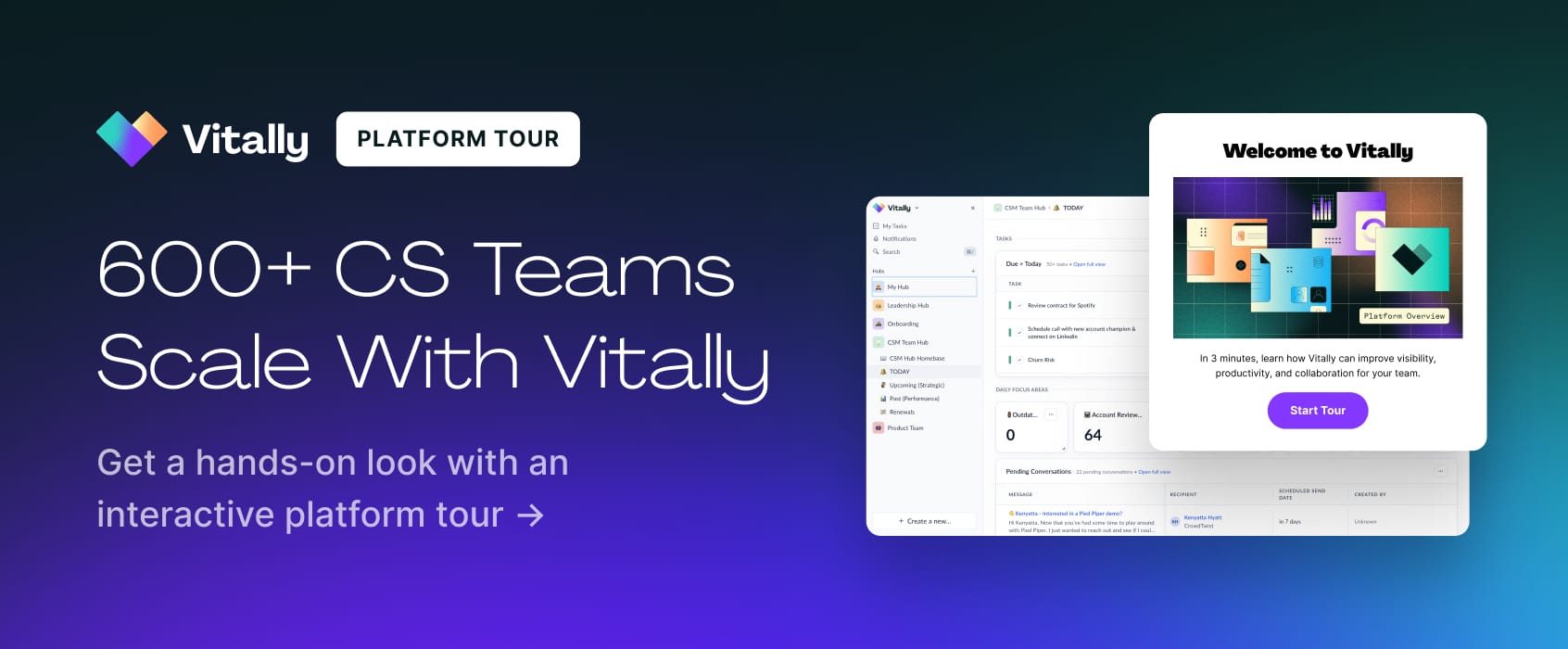
One of the biggest — if not the biggest — challenges I see Customer Success Managers (CSMs) face is the prioritization of seemingly infinite customer tasks. There are so many things a CSM or Account Manager (AM) could work on each day, but knowing what should be completed each day? That’s a whole different story.
I’ve learned that to feel confident with how I’m helping my team prioritize the slew of tasks coming their way, I need knowledge that’s grounded in data.
To me, data is two-fold. First, there are the hard numbers. These are the quantitative metrics that people think of when they hear the word “data.” For CS, it’s things like log-in rate, customer lifetime value, and Health Score. The other part of data that often gets overlooked is the qualitative stuff you can’t pull into a neat and tidy dashboard. The only way to capture this data is through one-to-one, human interaction with customers.
I’ve been leading a team of Account Managers for just over a year as of writing this, and during that short time, I’ve coined the term “collect the dots” with my teammates. It’s an invitation to invest the time it takes to gather both quantitative and qualitative data about each account.
But, it’s not enough just to capture a lot of data. Once we’ve collected the dots, I coach my teammates to paint a picture from all of those data points to connect the dots. Time is finite, so the question then becomes, “How are we going to spend our time?”
This is where having different data points allows CSMs and AMs to prioritize accounts and make decisions without second-guessing themselves. Said differently, leveraging data to prioritize where to spend your time eliminates guesswork and leads to better decisions.
Here’s an inside look at how my teammates and I leverage data to make customer-focused CS decisions at Mosaic.
But First, a Caveat: I’m Lucky
It’s important to preface everything I’m about to tell you by saying that I’m spoiled at Mosaic. We’re a uniquely data-driven organization, and I’m able to pull in a lot of different usage data directly from our platform into a Snowflake instance, and then from there into Vitally.
This access to data and the ability to organize it in a digestible format was by no means just a CS team effort. It was an all-hands-on-deck project involving the Mosaic CS team, engineers, and consultants at Snowflake and Vitally. But, once we had this data organized, what was muddy before became a lot clearer.
Having all this information at our disposal is a privilege, and I recognize that fully. But regardless of what your data landscape or team resourcing looks like, here are two tactics to get better data every time:
- Ask your customers more thoughtful questions: If quantitative data is limited, place a bigger emphasis on asking strategic questions during your Executive Business Reviews. Every question the Mosaic CS team asks is intentional and answers are combed with a tracking mechanism to get insights into their adoption, experience, and sentiment.
- Take note of non-product-related customer milestones: Take the time to get to know your customers outside of just their usage of your product. Having casual data points about your customer’s broader company — like fundraising goals, potential M&A plans, an upcoming switch from Hubspot to Salesforce — helps you see the big picture so you can keep your solution relevant for them.

4 Data Strategies I Use at Mosaic to Make Better CS Decisions
I mentioned it before, but I can’t underscore this point enough: Simply having a lot of data doesn’t mean anything. What counts is how you use the data. Here are four strategies the Mosaic CS team and I lean on to get the most out of our data:
👀 Go and See
One of my team mottos is “go and see.” What I mean by this is that effective Customer Success teams pair the rich quantitative data about their product usage with the qualitative data coming in from customer conversations to put together a cohesive picture of each customer.
By combining the two types of data, you’ll be able to understand your customers beyond just how many times they logged in last month. Knowing that is useful, but it certainly doesn’t tell you everything you need to know. So, I make it a point with my team to keep an emphasis on being inquisitive with the intent of helping our customers get the most out of the product.
Note: The goal isn’t necessarily to get more dollars in the door every time; it’s to provide a top-notch customer experience, and not ask questions we can answer ourselves. And yes, this does result in customers becoming more sticky, but we’re not solving for revenue. We’re solving for value.
🚫 Don’t Put All Your Stock in NPS
A lot of CS teams live and die by NPS. But NPS is overrated if you ask me.
Of course, when you think about the law of large numbers, the more NPS scores you collect, the more meaningful the overall number. In my opinion though, NPS is a product of an industry trend of over-automation.
What I mean by that is I would rather talk to our customers one-on-one and hear how they’re feeling versus have them click one button that says how likely they are to recommend our product to someone else. We haven’t run an NPS campaign at Mosaic in over two years — and that’s not to say we’ll never run one again. NPS just doesn’t give us the caliber of data we want.
Related: 8 Survey Questions CS Teams Should Ask Their Customers
✌️ Only Solve for Two Metrics at a Time
If you’re a data-driven organization like Mosaic, it’s tempting to fall into the trap of focusing on too many different data points at once. As a CS organization, you should really only be solving for two, or maybe three, primary metrics at a time.
If you’re trying to fix your onboarding timeline, retention rate, NPS, adoption score, and Health Score formula all at once, you’re not actually focusing on anything with the right level of intent.
It’s impossible to do everything at once, so work with your leaders to choose a few metrics to dial in on this year. The key is to keep your focus narrow enough that the CS team can devote enough energy to improving them, but also broad enough that it moves the needle for the business in more than one direction.
One final comment here: Create goals that are specific to your business and CS organization as opposed to the industry benchmarks. Instead of blindly trying to hit the industry benchmark for net dollar retention, come up with a benchmark and target that makes sense for how your business and customers operate right now.
💡 Lean on the Numbers, But Take Your Gut With You
Despite our access to immense amounts of data, I coach our CS team not to die by the data. I believe in gut instincts and the human ability to see beyond the numbers.
For example, a customer might look green on paper. Let’s say they have a great adoption rate and the login and usage statistics look good. But, something they said during your last EBR just didn’t sit right. Just because a customer looks green doesn’t mean they’re not a flight risk.
Coach your team to value data, but remain human and trust their instincts. You want them to use data to their advantage, but not rely on it so steadfastly that they become robotic.
My final thoughts: Ask yourself “why?” constantly
To paraphrase my guy Simon Sinek, it all goes back to “why?” If you don’t start with understanding why you’re tracking a specific metric, then it’s not worth tracking. If the why isn’t clear, you’re likely forcing work that may not need to happen or isn’t being pointed in the right direction.
-----
We hope you enjoyed learning about Mosaic’s approach to data from Caden. If you want to keep reading and learning, visit the Success Network, a community-focused content hub featuring tips and innovative strategies from top thought-leaders in CS.









